STAS 10th: Evan Dorkin & Sarah Dyer on "Superman Adventures"
Interview Conducted
by Edward Liu
To commemorate the impending 10th anniversary of Superman the
Animated Series, Toon Zone News and the World's Finest Online have
teamed up for an interview series with an assortment of people
associated with the show or the tie-in Superman Adventures comic book
series.
Evan Dorkin and Sarah Dyer have accumulated an extensive pedigree in the
world of independent comic books, both independently and as a team.
Dorkin's work includes the long-running Dork and Milk and Cheese comic
books, while Dyer's Action Girl Comicsanthology/'zine showcased a
variety of female cartoonists to create "girl-positive and
female-friendly" comics that were not anti-boy. The two made the jump
into animation writing with a gig on Space Ghost Coast to Coast, and
have also done a pilot for Adult Swim (Welcome to Eltingville, based on
Dorkin's Eltingville comic strip).
Toon Zone News and the World's Finest Online caught up with Dorkin via
e-mail and with both Dorkin and Dyer in person at the MoCCA Art Festival
in June to ask them about their episodes of Superman the Animated
Series and the four issues of the Superman Adventures comic
book they collaborated on.
September 06, 2006
 WORLD'S FINEST/TOON ZONE NEWS:
How exactly did you guys get the job to write for the TV show and the tie-in
comics? Which came first? WORLD'S FINEST/TOON ZONE NEWS:
How exactly did you guys get the job to write for the TV show and the tie-in
comics? Which came first?
EVAN DORKIN:
We had become friends with Paul Dini after meeting him at the San Diego
Comic-Con several years before we worked on Superman. He had bought a
page of Milk and Cheese artwork from me at the show and introduced
himself, and we stayed in touch. Originally, Paul had asked me to write
something for Freakazoid, while the show was starting up. I was working
on the plot breakdown when Paul and several other people left the staff of
Freakazoid, and my job went south along with them. From what I was told –
and what the original development material bears out – Freakazoid was
changed by the top executives from a funny action/adventure superhero show to a
Tiny-Toons-style superhero comedy, and several of the producers balked at
this. They also wanted to severely ramp up the merchandising potential of the
series, which certainly didn’t quite work out like they wanted it to.
Anyway, when Superman
ramped up Paul contacted Sarah and I – we had been working on Space Ghost
Coast to Coast at the time – and offered us a script. It was originally
supposed to be about Funky Flashman and Goody Rickles, two insane characters
Jack Kirby created for his Fourth World books at DC in the 70s, but those plans
never panned out. Instead we were assigned the Livewire intro, which was
intended for season one but ended up in season two.
As for the comics, Sarah had the
idea to gather up a lot of material we liked for the Supergirl two-parter that
WB cut and work it into a one-shot story for DC. The original “Little Girl Lost”
plot was changed significantly fairly last-minute and we had a significant
amount of backstory worked up for it as well. In a nutshell, we approached DC,
and they went for it. The Supergirl comic was supposed to be a one-shot, but
because of scheduling delays with the two-part episode, DC held it, and it ended
up becoming a giant-sized issue of the regular Superman Adventures book (Superman
Adventures #21 – ed). We did three more issues, including a sequel to the
Supergirl issue.
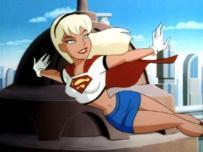 WF/TZN:
It's a long way from material like Space
Ghost and Milk and Cheese to superheroes, and Superman in particular.
Why do you think Dini asked you to write for Superman? WF/TZN:
It's a long way from material like Space
Ghost and Milk and Cheese to superheroes, and Superman in particular.
Why do you think Dini asked you to write for Superman?
ED:
One of the reasons Paul wanted to use us was because he knew we liked
superheroes, but we weren't so reverent to them that we'd do the same old thing.
There's not a lot of room in animation done for a corporation to do anything
really crazy. A lot of our goofier ideas and crazier dialogue got kicked out,
but that happens to everybody. It's not like we were trying to be animation
rebels. We weren't trying to make it South Park or anything like that. We
just wanted to make it cool and hopefully it was.
It's Superman, and Superman's hard. There are very set
parameters on him. If you mess with him, people think it's retarded, and when
you don't mess with him, people think he's boring. That's why I thought it was a
great idea to bring the Kirby stuff in there. I wish we got to work more with
that ourselves, and I think that really worked well. I was really sorry when
they pulled the plug on the show, too. I always felt that Superman was the
red-headed stepchild of the Warner Brothers shows. As soon as they got the
rights back to Batman, it felt like everybody ran from Superman. The fans loved
the show, but when Batman came back, they were all so excited. To be quite
honest, when it all calmed down, I think people were more excited about the
second half of the Superman shows than they were about the new Batman shows. The
Superman shows got really solid, and in some ways it became the Justice League.
I don't know if they knew that was coming, but they really just became the DC
Universe show. A lot of what drives a Superman show is what's going on around
him, whereas Batman you can do a show without a villain.
But Superman is really tough – he's an old character and
he relates to a different time. He's very black-and-white, and when you gray him
up, it becomes a lot harder. I think that's another reason why Captain America
suffers. I'm not a social scientist, but they just don't work as well as the
grittier characters, who have their own problems, but nowadays guys that pick up
guns do a lot better in superhero comics.
 WF/TZN: You were one of a small number of
people who worked on both the show and the comics. Did you get to
communicate more with the show producers for your comic book work as a
result, or get the flow going in the other direction?
WF/TZN: You were one of a small number of
people who worked on both the show and the comics. Did you get to
communicate more with the show producers for your comic book work as a
result, or get the flow going in the other direction?
ED:
We didn’t communicate much at all with WB in regards to the comics. I think we
asked Paul a few things regarding continuity, and requested some reference
material on Mala and Jax-Ur, things like that. We didn’t have a lot of close
communication with WB on the whole. We dealt mainly with Paul, and we were
freelancing out of NYC while they were in L.A. I’ve met very few people from the
series – Bruce Timm several times, and Glen Murakami – but that’s largely it. We
did get to work with Bret Blevins on two of the comics, he was one of the main
board artists on Superman the Animated Series and did a fantastic job
with the comics. We were very happy with what he brought to the material.
WF/TZN: There are a lot of writers credited
for the two-part "Little Girl Lost" episodes. How did your contribution fit in
with the other writers on those episodes?
ED:
Sarah and I have writing credits on both episodes. Paul and Alan have co-writing
credits on part one, and we have a story credit on the second episode, but I
forget the name of the writer (Rich Fogel -- ed). The second half was changed
fairly last minute and a regular series writer reworked the plot. Originally,
Granny Goodness was bringing together wayward teens and training them with
Apokolips technology because she was harvesting them as source material for
creating new Parademons. It was a riff on Pleasure Island from Pinocchio,
where the kids are taken in and transformed into donkeys. Here, the kids were
taken to Apokolips to be transformed into Parademon troopers to bulk up
Darkseid’s army. It was going to be revealed that Parademons were all
genetically-engineered beings: Armaghetto inhabitants, slaves, captured aliens
(Thanagarians, Martians, etc). We were going to show this huge, Nazi-like Krupp
Works for Parademons with beings on chains being dragged into chambers where
they’d emerge as soulless Parademons. The two-parter ended with Supergirl and
Superman in full-scale battle on. Anyway, from what I was told, a producer who
had signed off on the original premise balked and then asked for changes. We had
already done several drafts, and after they handed us the new plot, we ended up
doing another slew of drafts. It was nuts.
We were pretty disappointed, to
be honest. I still like the episodes a great deal, but we preferred the original
premise, and after all was said and done we were no longer the sole writers on
the shows.
WF/TZN: It seems that a lot of the comics
you worked on involved Supergirl. Was that a conscious choice on your parts?
ED:
WB asked us to work on the Supergirl intro, and we enjoyed working with the
character a lot and wanted to write more material for her. We never got to do
any more work for STAS (we were hoping to work on the Supergirl/Batgirl
episode, and at one point it was floated by us, but it just kept floating by,
unfortunately). As I said, Sarah had the idea to rework a lot of the extra
Supergirl material and notes we had into the DC one-shot. Then we had an idea
for the sequel story where she goes back to Argo to bury her family (in
Superman Adventures #39, "Reunion" -- ed). That was really all that was
behind it. We always wanted to do more with Supergirl, but we also had about a
dozen plots for Superman stories we hoped to do as comics. We just never found
the time to work it into our schedule.
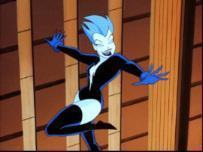 WF/TZN: You two wrote "Livewire" for the TV
show. In general, how do the two of you collaborate on scripts? Were you happy
with how the episode came out? WF/TZN: You two wrote "Livewire" for the TV
show. In general, how do the two of you collaborate on scripts? Were you happy
with how the episode came out?
ED:
Generally, Sarah and I talked about a script, and then did separate passes, I’d
start writing, then she’d rewrite and add material and edit my stuff, then back
to me, then eventually we both did a polishing draft together. It didn’t always
work like that, but in general that was the approach. On “Livewire” we were
handed a pretty loose springboard, which we fleshed out and then reworked after
cuts and changes were made by WB, and then we wrote the script.
I’m not crazy about the episode,
I wanted a bigger ending and I think a few things fall flat, partly because of
our inexperience and partly because the producers were getting the hang of the
series themselves. The earlier shows are stiffer than the later ones. "Livewire"
was supposed to be a first season episode, and the early premise had a lot more
material about how people were coping with the concept of having Superman in
their midst. He was supposed to “come out” in the episode, appear publicly for
the first time and address the citizens of Metropolis, answering public concerns
about his being a potential threat, or posing as a hero to cover a plot to
invade the planet by his fellow super-beings. I think that lent itself to some
more interesting material than what we got, which was fairly standard. There are
a few nice bits, but the animation is a little choppy and we had a more
explosive, violent ending, which wasn’t how it ended up. These things happen. I
think we turned in better scripts for “Monkey Fun” and “Little Girl Lost” based
on the experience of seeing our first script animated. You can’t really call
Space Ghost “animated”, so this was a big first for us.
WF/TZN: Did you follow Livewire's migration
to the regular Superman comics at all? If so, did you like it?
ED:
I didn’t even know she was featured in the regular-continuity comics until
someone wrote something about it on my LiveJournal a few weeks ago. I don’t know
anything about it.
WF/TZN: "Monkey Fun" introduced Titano, and
felt a lot like a 50's-era Superman story. Is there a story behind that episode?
Or was it just a great excuse to put a gigantic chimp on the show?
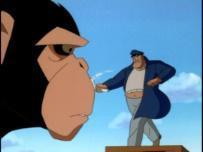 ED:
Who needed an excuse? Everyone likes monkeys and Titano was already an old
Superman character, so it was a natural. I was really pleased with this one, and
glad they gave it to us to do. My only regrets about this show was I wished we
could have had at least one standard Toho/Harryhausen-type shot of Titano
rampaging through Metropolis and causing some major destruction. If you have a
giant monster on the loose, you have to show them really cutting loose at least
once. All the rampage stuff had to be cut for time. But they should have had at
least one, brief city stomp shot to put the monster stuff over a little more
effectively. Minor complaint aside, I really like that one, I think it works. I
don’t think the fans thought much of it because it was a humor episode and
Titano didn’t constitute a “cool” cameo, but I really like it. ED:
Who needed an excuse? Everyone likes monkeys and Titano was already an old
Superman character, so it was a natural. I was really pleased with this one, and
glad they gave it to us to do. My only regrets about this show was I wished we
could have had at least one standard Toho/Harryhausen-type shot of Titano
rampaging through Metropolis and causing some major destruction. If you have a
giant monster on the loose, you have to show them really cutting loose at least
once. All the rampage stuff had to be cut for time. But they should have had at
least one, brief city stomp shot to put the monster stuff over a little more
effectively. Minor complaint aside, I really like that one, I think it works. I
don’t think the fans thought much of it because it was a humor episode and
Titano didn’t constitute a “cool” cameo, but I really like it.
WF/TZN: Did you have any input on what Livewire or
Supergirl or any of the other characters on the show would look like?
ED:
Livewire, we had nothing to do with. We just saw the sketches as they came in.
For Supergirl, Sarah went to L.A. and hashed out a lot of material with Paul
Dini and a lot of the other people.
SARAH DYER:
With Supergirl, we didn't really have a lot. I was out there, but I wasn't
really involved. Some of the artists seemed to say that they did keep writers in
mind. For example, for the "Livewire" episode, Superman saves a baby, and they
deliberately drew the baby so it would look like Evan drew it, they told me, as
a little tribute. Some people would say that they would keep you in mind, but we
didn't have any involvement. We didn't do any sketches or give them any ideas.
If we had any effect on it, it was really just the artists saying, "I want to
make it go with the writer a lot more," but we didn't have any direct
involvement.
WF/TZN: Did your work with
Action Girl affect how you wrote Supergirl at all?
SD:
I wouldn't really know. Possibly, but I couldn't say. I'd be a huge egotist if I
did (laughs).
ED:
I think that when we were writing it and where she was coming from with
Action Girl, we would talk seriously about what we didn't want to do
with the character. Girl characters are always written kind of like how
minorities are written in animation and film way too often. It's like this
Batwoman they're putting out there – "She's a Lesbian!" is all you know about
her. It's ridiculous.
We wanted to make sure that she
was someone who didn't have a lot of angst. She liked her powers – if you notice
in the episode, she's not like Superman at all. The whole point was that she was
pretty comfortable with powers. She didn't have "girl" problems. It wasn't "a
Very Special Episode of Superman…with Girls." I hate this term, but we
just wanted it to be kind of kick-ass without calling too much attention to it.
The contrast was that she was very confident – in fact a little overconfident –
and she really enjoyed her powers.
We not saying it was a political
issue – you know, "we gotta do this for the little girls of America" – but we
got really good feedback from the comic, especially, from parents whose little
girls really loved the character and really got into her. In some ways, that's
the spillover from Action Girl. We didn't want to do anything
condescending with the character and any comments we made about her being a girl
were tongue-in-cheek or natural, we hope. We didn't want to have any "…and she's
a GIRL!" moments.
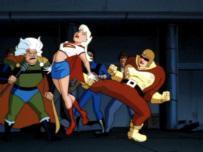 I mean, she gets her head kicked
in. She's a superhero. This is the genre. She hits people, but they also hit
her. None of that stuff where the girl only gets tripped or hit with energy
beams. In the comic, we worked her over, but we didn't treat her any differently
that way. Her fears and problems had nothing to do with her being a girl and
everything to do with her being a person, and we did get a really nice response
to that. I mean, she gets her head kicked
in. She's a superhero. This is the genre. She hits people, but they also hit
her. None of that stuff where the girl only gets tripped or hit with energy
beams. In the comic, we worked her over, but we didn't treat her any differently
that way. Her fears and problems had nothing to do with her being a girl and
everything to do with her being a person, and we did get a really nice response
to that.
WF/TZN: Did you ever consider doing the
artwork for one of the Superman Adventures comics?
ED:
Not really. I mean, sure, I had the urge, but I know my limitations as a
superhero artist. For me to do a halfway-decent job on a single issue I’d need
several months because I’d sweat it. I’d sweat doing the Timm-style and worry it
didn’t look good enough. There are a lot of talented people who work that
animated style, I’d need a lot of lead-time to look one twentieth as good as
Rick Burchett or Bret Blevins or Mike Manley or Ty Templeton, to name just a few
at random. Not to mention the WB artists and designers.
I did design some
of the characters for the comics we wrote, like the General Zod design and the
design for the female Brainiac from the “Reunion” issue. That was a lot of fun,
but it was isolated and I could spend a lot of time trying to get it right. And
even if I didn’t, my drawings never saw print – they were interpreted by Bret
Blevins, who did a great job. I also did a Solomon Grundy re-design in the
animated style for a proposed comic script, but we never got to write the story.
WF/TZN: Was there anything special in your landing the assignment to write
the last 2 issues of the series?
ED:
Not at all. We took so long to get those scripts in that they simply ended up as
the final two issues. They were never assigned as the series ender. If I knew we
were writing the final storyline, we would have gone all-out. I still cringe at
the fact that the series went off on those two issues, since they weren’t
supposed to be the finale of the series and, quite frankly, they weren’t all
that good. They just didn’t come off the way we would have liked them to. Our
scripts were over-written and needed more editing by us (and there was some
confusion that led to one issue being lettered from an unedited version of the
script), and the art was a bit of a mess. I’m not happy with those issues at
all. I like the plot and the premise and a few bits of business, but that was no
way to end a really nifty series.
WF/TZN: Did you ever get the urge to go all
"Milk & Cheese" with Superman to see what would happen?
ED:
It’s not something I’ve given any real thought to. Maybe Milk and Cheese go all
Milk and Cheese on Superman, he’s usually a real uptight character. I’m more
inclined to have Milk and Cheese go all Superman, actually. I have a Milk and
Cheese superhero strip in my files that I may do for the next issue,
 WF/TZN: Along those lines, are there any
stories you can share about things you had to cut from either the TV show or the
comic book?
WF/TZN: Along those lines, are there any
stories you can share about things you had to cut from either the TV show or the
comic book?
ED:
Well, there’s the stuff I mentioned before, but that’s pretty much it.
"Livewire" was supposed to have a lot more about Superman’s position in
Metropolis and people learning more about him and how his legend was growing,
and was to have a more packed ending. "Monkey Fun" lost some giant monkey city
trampling, and a scene where Superman was swallowed by Titano and spit out into
a car like a bullet, and finds himself completely covered in giant gurvy monkey
spit. Nothing major, just some cute bits, we thought. A lot of stuff was changed
in "Little Girl Lost," as I said, but we got to use a lot of our back story and
some bits of business in Superman Adventures #21 issue.
I do wish the Apokolips ending
was retained. I always thought the giant meteor/comet from space was hokey and
made very little sense as a reason for Granny to break the pact and traffic with
a bunch of useless kids. Body harvesting kids for shock troops was creepier,
made somewhat more sense, and was very Kirby/Apokolips in tone (at least in my
opinion).
I can’t think of much else.
There’s always dialogue and sequences that are changed, lost, or truncated, but
everyone goes through that – its not just our scripts by any means. We were very
lucky in many ways, because a lot of our material remained after the process. On
the whole, it was a very good experience. Only some of the Supergirl changes
smarted, especially after we went though over 20 drafts, major and minor,
between the two scripts. That was a real haul.
WF/TZN: What was the biggest
surprise for you while writing for the show and/or the comic?
ED:
No surprises working on the comic, other than the fact that the animated shows
were really popular but DC couldn’t get anybody to read the comics – even though
creators from the cartoons often worked on them and people would buy the action
figures in droves. Working on Batman Beyond was more of an eye-opener
than working on Superman, because we got to see what it was like to work
on a show that wasn’t firing on all cylinders. We learned about how budgeting
affects a script or episode, what it’s like to work on a show without a complete
bible, and how writers and board artists can extensively alter your script. We
didn’t experience many of those things – at least not to that degree – on
Superman.
Other than that, the biggest
surprise was that the WB unit had a rift of sorts between the writers and the
artists, more or less two camps that didn’t always get along and didn’t always
communicate well enough. It affected at least one script of ours, the Batman
Beyond one. Very weird. But we were able to avoid office politics, because
we were far away, low-level freelancers, and no threat to anyone.
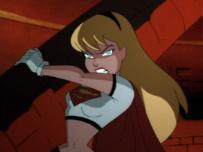 WF/TZN: What would you go back and do
differently with the benefit of hindsight? WF/TZN: What would you go back and do
differently with the benefit of hindsight?
ED:
Punch up and polish and edit. Especially on "Livewire" – it needs some added
energy, no pun intended. And I would try harder to get a few script assignments,
which were dangled in front of us but never came about. We were too laid back,
and nervous about asserting ourselves, myself more than Sarah. On several
occasions someone would ask us how we felt about doing a script with
such-and-such a character, and I’d get all excited but wouldn’t follow up. I was
just so happy to have the gig I never really pushed. I’m bad at that sort of
thing. The phone has to ring, I’m not good at making the call. We were asked
about doing some Batman scripts, and I still remember getting very worked
up when the Creeper episode was mentioned, but instead of keeping on it, we
waited to hear from the producers. I’m not implying we would have gotten the
Creeper episode, or any additional work, but I wish we had tried for more. We
were pretty busy with Space Ghost and our comics, but I did want to try a
Batman episode, or another Supergirl episode. I’m happy we did what we
did, though.
WF/TZN: What are you working on now, separately
and as a team?
ED:
Sarah and I are about to go into production on a pilot for the Cartoon Network’s
Adult Swim called Tyrone’s Inferno. It’s a fifteen-minute pilot, about a
demon who’s so obnoxious he gets kicked out of Hell to spend Eternity on Earth.
He lives in a trailer park where he plots various revenges or just eats crap and
watches TV. It’s sort of Milk and Cheese-like in tone and extreme
violence, sort of Little Rascals meets The Young Ones in The
Twilight Zone in pitch-speak. Hopefully it’ll get made.
We’re also doing the English
scripts for an anime series that Funimation has licensed (since revealed to be
Crayon Shinchan – ed), and we’ve recently done comics and spot
illustrations work for Mad, Mad Kids, Nickelodeon Magazine,
Spin and Maxim U.K. Sarah’s doing rewrites for several Tokyopo
manga series. I’m working on Dork #11, new Milk and Cheese strips for the
Negative Burn comic anthology, and some scripts for Bongo’s Bart Simpson
comic. We’re also working on a set of Milk and Cheese vinyl figures with Slave
Labor Graphics for later this year, and I’m doing a 20-page horror story with
artist Jill Thompson for the upcoming Dark Horse Book of Monsters.
Toon Zone News and the World's Finest Online would like to
thank Dorkin and Dyer for their time. The pair's website is at
www.houseoffun.com, where
you can keep up to date with the latest from the duo.
This interview co-published with the
Toon Zone
News. Scans from Superman Adventures courtesy of Toon
Zone News.
Past Superman the Animated Series 10th Anniversary Interviews:
- Neil Vokes
- Scott McCloud
- Mark Evanier
|

